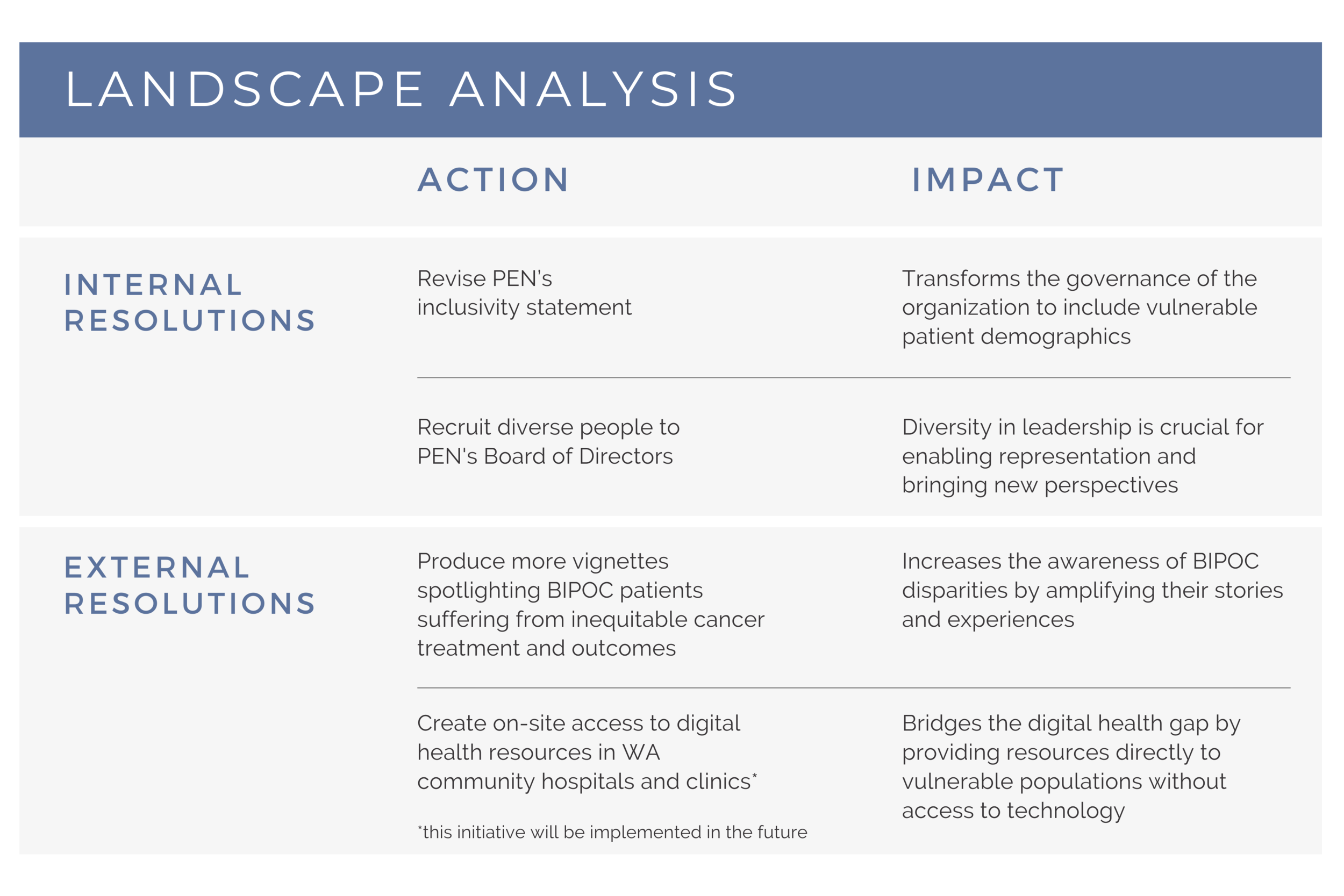A Landscape Analysis for Equity, Diversity and Inclusion
HEET Members
Brooke Gentry-Strohm
Tamara Lobban-Jones
Christian Strohm
External Resources
Dan Hogan
Completed
2021
Partner Organization
Patient Empowerment Network (PEN), a cancer patient health literacy nonprofit organization.
Summary
PEN enlisted the HEET to conduct a high-level landscape analysis of PEN’s organization to identify how it could integrate Diversity, Equity, and Inclusivity into its values and actions. Using the findings from an organization-wide survey, the HEET identified and recommended actionable steps for PEN to become more inclusive to underserved patients in vulnerable communities. PEN resolved to implement both the internal and external resolutions borne from collaborative discussion around the landscape analysis. Both organizations viewed this undertaking as successful.
Introduction
The Patient Empowerment Network (PEN), a cancer non-profit organization, enlisted the Health Equity Emissary Team (HEET) to conduct a Landscape Analysis to assess PEN’s current organizational landscape, and identify how PEN could integrate Equity, Diversity, and Inclusivity (ED&I) into actionable resolutions.
The HEET composed a survey to assess PEN’s existing values and actions. The HEET identified areas for PEN to implement ED&I into its existing infrastructure. The HEET presented this survey and its findings to PEN’s Board of Directors (BoD) and senior staff. Moreover, PEN’s BoD and select HEET members formed a subcommittee to oversee the implementation of these ED&I initiatives and actionable resolutions.
“The HEET asked essential questions that encouraged us to broaden our collective perspectives. This reflective exercise empowered us to execute our resolutions mindfully as a cohesive unit. Our experience with the HEET has set us on a path toward more meaningful cultural competency.”
Approach
The HEET created and deployed a survey with short-answer questions to PEN’s BoD and staff on ED&I values and practices. This survey emphasized intentionality, probing why the organization believes it is important to serve vulnerable populations. Questions were formulated to create tangible resolutions and practical steps. The survey response findings were divided into an internal and external analysis.
The internal analysis focused on PEN’s underlying governance of values and practices, encompassing both leadership and staff. Based on the survey responses, the HEET recommended the recruitment of diverse people to the BoD and a resolution to revise PEN’s inclusivity statement to better embody ED&I values.
The external analysis focused on implementing ED&I in action. The first resolution was for PEN to produce more self-advocacy vignettes that feature BIPOC (Black, Indigenous, and People of Color) cancer patients suffering from healthcare disparities. The second resolution was for PEN to provide on-site digital access directly to underserved patients. In the future, PEN plans to partner with Washington clinics and hospitals to bridge the digital health gap.
The survey and its findings were illuminating and well-received by PEN’s BoD and staff, who answered the questions in detail and agreed to move forward with the HEET’s recommendations. In addition, select members of the HEET and BoD formed a sub-committee to oversee the implementation of the resolutions.
Following the HEET’s findings from the Landscape Analysis and subsequent recommendations, the HEET and PEN’s BoD collaboratively discussed the next steps, and the ED&I initiatives to focus on. In order to organize their plan of action for the next steps, PEN resolved to pursue both the internal and external resolutions established during the Landscape Analysis.
Internal and External Resolutions
Conclusion
The HEET’s Landscape Analysis enabled PEN to see how they could become more equitable, diverse and inclusive as a healthcare organization. These findings helped PEN mobilize actionable resolutions to provide vulnerable, underserved communities with cancer health resources.
Drawing on the HEET’s diversity of professional and personal experiences, the HEET helped initiate crucial dialogue around health disparities with PEN’s BoD and staff. This inspired PEN to integrate ED&I within its organizational infrastructure, culture and value system.
Throughout this initiative, PEN and the HEET collaborated closely, which demonstrates the boundless potential of collective action between organizations with aligned intentions. The coalition of organizations like PEN and the HEET amplifies the reach and impact of each other’s existing efforts to effectively address health disparities and promote health equity.
The Health Equity Emissary Team (HEET) works directly with healthcare organizations to build diverse leadership teams, consult on high-level organizational strategy and produce educational content for patients and families. We are an inclusive peer network who spotlights health disparities and improves health outcomes of BIPOC health communities. Please email [email protected] to learn more.



